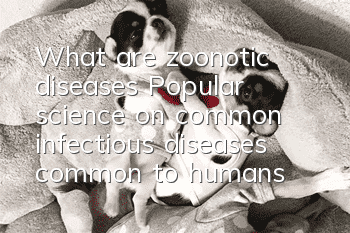What are zoonotic diseases? Popular science on common infectious diseases common to humans and dogs

Zonotic Disease 1: Rabies
It is a zoonotic disease caused by rabies virus, especially an acute contact infectious disease that pet animals are susceptible to. The disease is mainly infected by bites from mad dogs, mad cats and sick domestic animals. The disease can occur in all seasons, but is more common in spring, summer and winter. The incubation period of the disease varies, with the shortest being about 12 days and the longest being up to 1 year. Because the disease harms the nervous system, various sick animals show excitement and violence; the initial symptoms of the disease in sick dogs are panic, fear of stimulation, barking in the air, turning against the owner or being very close to them, licking people and foreign objects, and then the symptoms change. He goes into a violent rage, wandering around, shouting hoarsely, and shambling. In the later stage, he is characterized by strong energy and body paralysis. He usually dies 3-6 days after the onset of the disease. When cats are sick and provoked by others, they will also attack people, scratch and bite people and transmit the disease. Most animals suffering from the disease die, and a few develop chronic metastasis.
Zonotic Disease 2: Trichinella
Trichinella is a parasitic disease easily caused by humans and carnivores. People, dogs, pigs and cats are all highly susceptible. Patients become infected with cysticercosis by eating pork or dog meat containing Trichinella spiralis or coming into contact with fresh feces containing Trichinella spiralis. People susceptible to the disease can die from swallowing five live worms per kilogram of body weight. The main symptoms of the disease are fever, listlessness, early vomiting and diarrhea, muscle soreness caused by the cyst, difficulty walking, chewing, swallowing and breathing, swelling of the face and eyelids, loss of appetite, and ultimately death.
Zonotic Disease 3: Toxoplasmosis
Cats are the host of Toxoplasma gondii, which reproduces sexually in cats. Cats usually get the disease by ingesting raw meat or prey containing trophozoites. Once a person is scratched by a cat or infected through other means, some people may experience fatigue, fever and headache. The vast majority of obvious clinical symptoms are lymphadenopathy.
Zonotic Disease 4: Echinococcus
This disease is a parasitic disease in which the larvae of Echinococcus granulosus in the small intestine of dogs parasitize the liver, lungs and other internal organs of humans and animals. Echinococci are cyst-shaped, ranging from bean-shaped to small and ball-shaped, with different shapes. People suffering from this disease often suffer from long-term stubborn digestive disorders, malnutrition, shortness of breath, weight loss or jaundice. When the lungs are attacked, they will have wheezing and coughing. Sick animals sometimes suffer from anaphylactic poisoning due to the rupture of hydatid cysts in the body, which results in a large amount of cyst fluid that is difficult to absorb, resulting in shock or death. This disease is mainly transmitted by ingesting contaminated dog feces and grass water containing insect eggs. Humans are exposed to sick dogs or accidentally eat insect eggs.
Zonotic Disease 5: Leptospirosis
Almost all mammals can be infected with leptospirosis. Dogs and rabbits are reservoirs of Leptospira. Leptospira can occur when humans come into contact with animal urine, blood tissue, or the environment. The incubation period is about 10 days, followed by sepsis, headache, fatigue, muscle aches, fever, jaundice and hematuria.
Zonotic Disease 6: Scabies
It is caused by dermatophytes, and the epidermis of dogs and cats is susceptibledye. Infection to humans can cause ringworm or ringworm.
How to prevent zoonosis
1. Cull wild dogs and wild cats. Domestic dogs and cats must be tethered, and vaccinations must be carried out in accordance with government regulations.
2. Once a mad dog or cat is discovered, they should be killed and burned immediately. People and animals bitten by mad dogs and cats must urgently seek medical treatment for vaccination. Dogs suffering from various taeniasis can be treated with deworming if necessary, and others can be culled, and their feces should be disposed of harmlessly.
3. It is strictly forbidden for humans and animals to eat the meat of dead dogs. People should avoid eating half-cooked meat to prevent trichinella infection.
- Is it better for Dogo dogs to have their ears erect or cropped? A case of Dogo dog’s ear erection surgery will tell you
- What do dogs eat to protect their stomach? It is important to protect their stomach and treat gastrointestinal diseases in dogs.
- How to tell if your dog is fat? Is your dog overweight?
- Will your dog catch a cold if you blow the air conditioner? What should you do if your dog catches a cold if you blow the air conditioner?
- What should you pay attention to when your dog drinks water? Don’t be careless when it comes to your dog’s drinking water.
- The dog's mouth bites and shakes. Why does the dog's mouth occasionally shake and bite?
- How to cut a dog's hair? Do you know how to cut a dog's hair correctly?
- Can dogs eat raw eggs? Why can’t dogs eat egg whites?
- Common Dog Problems in Summer How to Deal with Different Dog Problems
- How to keep dogs away from skin diseases. If you do this, will you see if your dog will still be infected with skin diseases?



